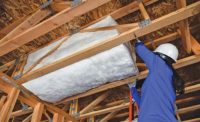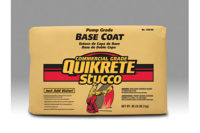Protecting a building’s exterior from outdoor elements, like rain, snow, wind and extreme temperatures, is top priority for contractors. Learning how to optimize structures in all parts of the country to withstand these elements is not only important in keeping the building’s exterior intact, but also to keep energy efficiency at an ideal level.
One proven way to protect a structure against unpredictable outdoor elements is through the installation of a rainscreen system. A rainscreen system is defined as the separation of an exterior cladding from the structural wall in an effort to manage moisture and energy transfer through the wall assembly.
Wall surfaces do not have to be waterproof to resist rain or snow, but they do need to be able to prevent water from being absorbed or forced into the interior parts of the wall assembly, which impacts both building durability and energy efficiency. Effective rainscreen systems redistribute moisture held in the cladding to adjacent materials where it either evaporates or drains down and out the bottom of the wall. Water will attempt to enter the structure at any available point, from the roof down to the foundation. Therefore, incorporating a well-designed, high-performing wall system is critical.
In addition to protecting a building’s exterior, rainscreen systems can also aid in regulating indoor comfort. With the building envelope as the first line of defense, understanding how to incorporate a rainscreen system into a building envelope’s overall energy performance is crucial in helping to regulate indoor temperatures year-round.
When considering or working with a rainscreen system, it’s important to know three things. Understanding how rainscreen systems work with a variety of different cladding systems, how to incorporate a gap and how these systems can aid in energy efficiency are all key factors in implementing a rainscreen system that protects from outdoor elements and optimizes the building envelope.
1. Rainscreen systems can work with almost any cladding; enhancing aesthetics
With rainscreen facades, the cladding becomes the most visual part of the building, because the purpose of the cladding is not to keep out all of the water, just some. This can allow for more flexibility in design, creating more options for an aesthetically appealing exterior. Rainscreen systems can be incorporated with nearly anything as the cladding, including brick, stone, metal, wood or plastic composites. Because the final waterproofing layer is separate from the cladding, rainscreen systems simplify the transition from one cladding to another.
However, this doesn’t mean that one can ignore differences between materials. Consideration of the type of exterior building product is important in understanding how outdoor elements and building factors will impact the rainscreen system’s performance. For example, materials like brick and concrete are porous, allowing them to absorb and store water. While moisture-sensitive materials, such as wood, should be treated on all sides to prevent degradation.
2. Managing the gap is critical
A rainscreen system should always incorporate a gap between the outer cladding layer and the rest of the wall. This gap allows for any water that gets past the cladding to have a space to drain down the wall and directed out by flashings. Water could possibly run down the back of the cladding or the face of the water-resistant barrier of the rainscreen system.
For optimal drainage, the gap should be large enough, with open weeps or gaps at the bottom of the wall. Most projects can accommodate a gap that is one-eighth of an inch or larger. However, an even better gap is one that is 1 inch or more, with openings at both the top and bottom. A space of this size creates a vented cavity that not only allows water to drain, but also allows air movement to speed the drying of the cladding and the wall. Of course, neither water drainage nor air-drying is possible if the gap is clogged with mortar droppings or other debris.
Depending on the type of construction and cladding, rainscreen gaps can be created with the cladding support system, masonry ties, corrugated mats or textured building wraps. Screens are important to keep bugs or other pests out of drainage or vent holes. Maintaining the gap and keeping it clear is a key factor in ensuring the success of a rainscreen system.
3. Continuous insulation can help optimize the system’s energy efficiency
Behind the cladding and the gap is “the rest of the wall.” In addition to the main structural elements and cladding supports, this part of a rainscreen system needs to include the primary WRB layer, and might include an air barrier and exterior continuous insulation.
Including CI in a rainscreen system is an excellent way to support the energy efficiency goals of the project. Mineral wool boards, foam sheathing and closed-cell spray foam can all work as CI in a rainscreen system. For example, mineral wool boards are typically installed over the primary WRB layer and add an additional drainage surface behind the cladding, as well as a non-combustible insulation layer. Foam sheathing and closed-cell spray foam can be used as both the WRB and CI layers. Foam sheathing must have all seams taped and penetrations sealed and window and door flashings should attach to the face of the foam boards. With mineral wool and closed-cell spray foam, flashings typically go behind the insulation.
Thermal bridging in buildings can reduce energy efficiency, cause thermal comfort problems and can even lead to condensation issues. Therefore, reducing the risk of thermal bridging not only cuts down on energy costs, but also can reduce condensation that could cause mold, rot and rust and harm indoor air quality. Incorporating CI into rainscreen systems is a cost-effective and long-term solution for eliminating thermal bridges and maximizing energy efficiency and performance.
When a well-designed rainscreen system is properly installed with other insulation products, it provides added protection to the structure and can work as an additional barrier to control interior comfort and potentially reduce utilities costs.
Ultimately, rainscreen systems can be a very effective solution when incorporated correctly with different types of cladding systems, with the proper gap installed, and with continuous insulation that optimizes energy efficiency.









Report Abusive Comment